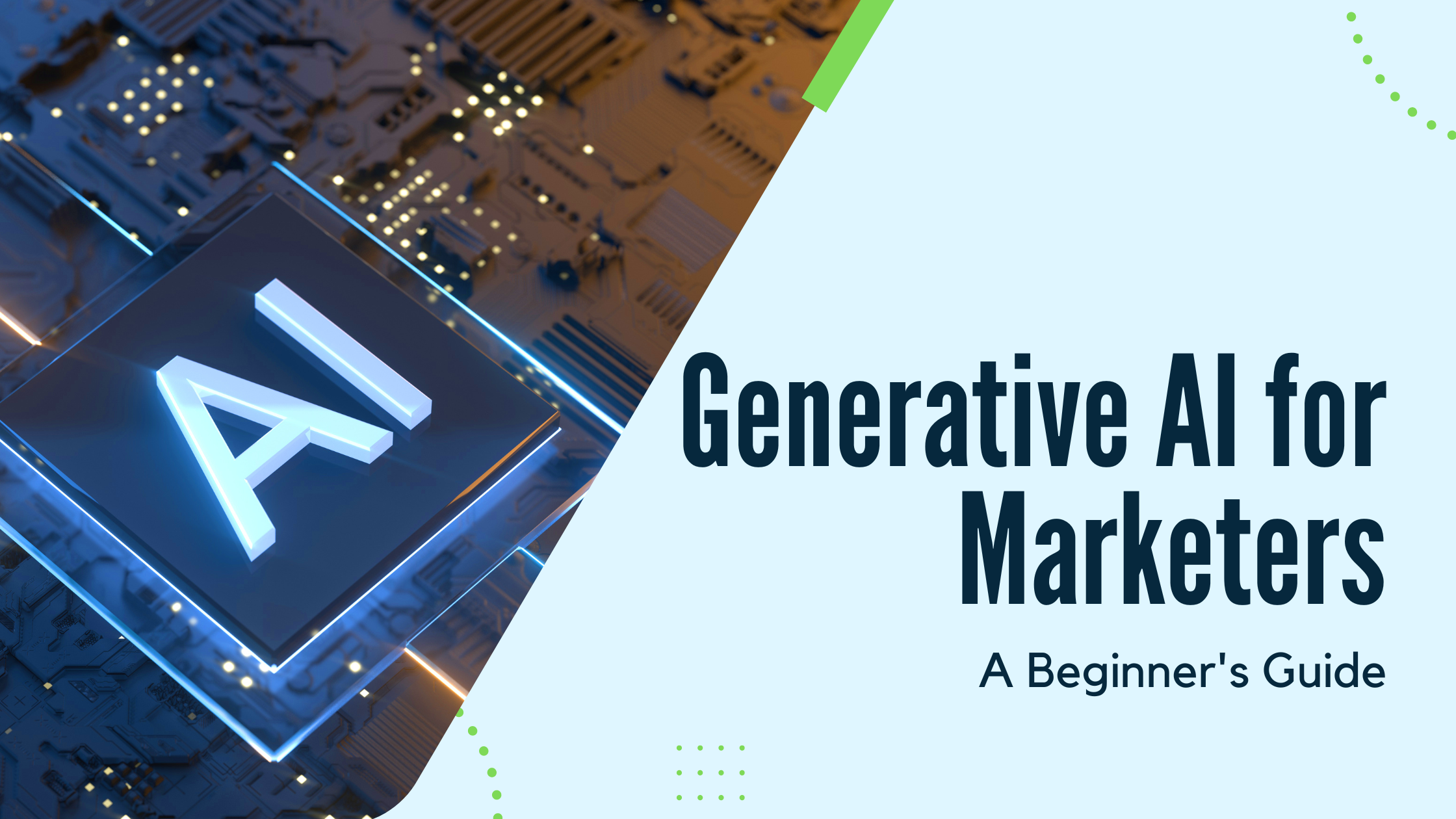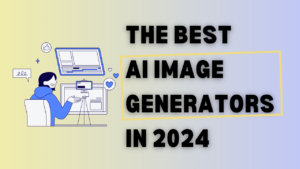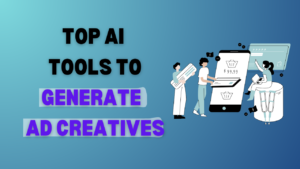Welcome to our comprehensive guide on Generative AI for Marketers. In the pages that follow, we’ll embark on a journey through the fascinating world of AI-powered content creation, personalization, and data-driven decision-making. Whether you’re a seasoned marketer looking to enhance your strategies or someone new to the field seeking to understand the latest trends, this guide is designed to be your roadmap.
Join us on this journey as we unlock the secrets of Generative AI and discover how it can amplify your marketing efforts.
What is Generative AI?
Generative AI is like having a super-smart computer assistant that specializes in making things like text, pictures, and videos. But it’s not just any assistant; it’s an assistant that learns from lots of examples to understand how things are usually done and then can do similar things on its own.
Here’s how it works:
- Learning from Examples: Imagine this computer assistant reading tons of books, articles, and websites to understand how words, sentences, and pictures are put together. It learns patterns, the way words fit together, and even the style of writing.
- Creating New Content: Now, when you give it a little hint or a starting point, it can use what it learned to create something entirely new. For instance, if you ask it to write about a new smartphone, it can write a description that sounds just like what a human would write.
The special thing about Generative AI is that it’s so good at this that sometimes it’s tough to tell if a human or a computer created the content.
So, in simple terms, Generative AI is like a creative computer helper that learns from examples and can make text, pictures, and videos that look and sound like they were made by people. It’s a powerful tool that’s changing how we create and use content in many fields, including marketing.
How is Generative AI different from Machine Learning
Machine Learning:
Machine learning is like a smart student who learns from examples. Imagine you have a friend who wants to learn how to identify different types of fruits or cars. You show them many fruits like apples, oranges, and bananas, and you tell your friend, “This is an apple,” “This is an orange,” “This is a Sedan”, “This is an SUV”, and so on. Over time, your friend gets really good at recognizing these fruits and cars because they meticulously studied and learned from the examples you provided.
In the same way, machine learning relies on lots of examples to make predictions or decisions. It is used in things like spam email filters, where the computer learns to identify spam by looking at lots of example emails that are either spam or not spam. Another example is facial recognition, where the machine learns to identify faces by analyzing countless images of people’s faces. Over time, the machine gets better at telling the difference.
Generative AI:
Now, think of generative AI as a creative writer. Suppose you have a friend who is an amazing storyteller. You give them a simple idea, like “Write a story about a magical forest,” and they can create a whole story from scratch, complete with characters, adventures, and dialogues.
Generative AI is a bit like that talented friend but in the digital world. It can take a simple idea or prompt and create something entirely new, whether it’s writing a story, generating artwork, or even making music. It’s like having a digital artist, writer, or musician who can invent things without needing lots of examples.
Key Differences:
The main difference is in how they learn and what they do:
- Machine Learning learns from examples and is great at making predictions or decisions based on patterns it finds in data.
- Generative AI, on the other hand, is creative and can generate new content or ideas based on the input it’s given
So, in a nutshell, machine learning is like a pattern recognizer, while generative AI is more like a digital creator. Both are super useful, but they’re used for different tasks and have their own unique talents.
Types of Generative AI Models
Several Generative AI models have gained prominence in recent years. Think of Generative AI models like different types of super-smart AI tools, each with its own unique capabilities:
- GPT (Generative Pre-trained Transformer): These models, like GPT-3, are experts at understanding words and how they fit together in a meaningful way. They’re really flexible and can be used for lots of different things. For example, they can help write stories, create product descriptions, and even answer questions in a way that makes sense.
- LLAMA (Language Learning and Modeling with Actions) by Meta: These models, such as LLAMA, excel in comprehending language and its contextual nuances. They exhibit remarkable versatility, capable of being applied across various domains. For instance, they can assist in generating creative narratives, crafting compelling product descriptions, and providing coherent responses to inquiries.
- BERT (Bidirectional Encoder Representations from Transformers): BERT is like a detective that’s really good at figuring out the meaning of words in sentences. It’s super useful for improving how search engines understand what you’re looking for when you type something in. It helps search engines give you better results.
- StyleGAN: This one is like an artist AI. It’s great at making pictures and videos look cool. So, if you need visuals for things like advertisements, websites, or videos, StyleGAN can help make them look awesome.
Understanding these AI tools is like knowing which tools to use in a toolbox. Each has its own special job, and in the upcoming chapters, we’ll see how they’re changing the way we create content, personalize experiences, and make decisions in marketing.
How Generative AI Helps Marketers
Imagine Generative AI as a helpful assistant for marketers. It’s like having a super-smart helper that can do a bunch of useful things. Let’s see how it works:
1. Creating Content That Gets Attention: Generative AI can help marketers make things like articles, ads, or social media posts. It’s not just about writing; it can also create images and videos. This content is designed to grab people’s interest and make them pay attention.
2. Making Marketing Personal: This AI can also make marketing feel more personal. It’s like when your favorite online store suggests products you might like based on what you’ve bought before. Generative AI can do that but on a bigger scale.
3. Understanding What People Want: It’s like having a magical tool that can look at tons of data and figure out what customers want. For example, it can see what people search for online or what they click on, and help marketers use that info to make better decisions.
Benefits of Generative AI for Marketers
- Content on Demand: Generative AI can create content whenever you need it. It’s like having a writer or designer available 24/7.
- Consistency: It’s great at maintaining a consistent style. So, if you want all your marketing materials to have the same feel, AI can do that.
- Time-Saver: You can get things done faster. Instead of spending hours writing or designing, you can use AI to speed things up.
- Big Data Analysis: AI is a pro at handling massive amounts of data. It can analyze it and give you insights into what’s happening in your market.
Challenges of Generative AI for Marketers
- Quality Control: Sometimes, AI might create content that’s not quite right. It might not understand context or make mistakes.
- Originality Concerns: AI can sometimes produce content that looks like it was copied from somewhere else. This can be a problem for uniqueness.
- Ethical Considerations: There are questions about using AI responsibly, like making sure it doesn’t generate harmful or biased content.
- Learning Curve: Using AI tools can take some time to learn, and not all marketers are tech experts.
Implementing Generative AI in Your Marketing Strategy
Incorporating Generative AI into your marketing strategy can be a game-changer, but the approach can vary based on your specific goals. Here, we explore how to effectively use Generative AI for different use cases:
Content Generation:
- Blog Post Writing: Automatically generate blog posts on various topics.
- Product Descriptions: Create compelling product descriptions for e-commerce websites.
- Social Media Posts: Generate engaging social media captions and posts. Check out some awesome Social Media AI tools that can help you with generating and repurposing your content.
- Email Marketing: Craft personalized email content and subject lines.
- Ad Copywriting: Create persuasive ad copy for online advertising campaigns.
Check out this list of 15 AI copywriting tools to boost your content generation
Content Optimization:
- SEO Optimization: Suggest SEO-friendly titles, meta descriptions, and keywords.
- Content Rewriting: Rewrite and refresh existing content for SEO and relevance.
- Content Summarization: Generate concise summaries of lengthy articles for quick consumption.
- Language Translation: Translate content into multiple languages for global marketing.
Personalization:
- Product Recommendations: Offer personalized product recommendations to website visitors.
- Email Personalization: Customize email content based on user behavior and preferences. Learn how to use AI to generate personalized videos for your audience with AI video generator tools.
- Dynamic Website Content: Display content tailored to each user’s interests on your website.
- Segmentation: Automatically segment your audience based on their behavior and characteristics.
Market Research and Analysis:
- Competitive Analysis: Gather insights on competitor strategies and market trends.
- Customer Surveys: Create surveys to gather feedback and insights from customers.
- Market Reports: Generate detailed market reports and analysis.
- Keyword Research: Discover new keywords and topics for content marketing.
Content Curation:
- Content Aggregation: Automatically curate content from various sources for newsletters or blogs.
- News Updates: Provide real-time updates on industry news and trends.
- Newsletter Creation: Generate newsletter content with the latest industry updates and insights.
Data Analysis and Reporting:
- Data Interpretation: Analyze data and present insights in a human-readable format.
- Performance Reports: Generate reports summarizing campaign performance metrics.
Email and Chat Support:
- Chatbot Conversations: Train chatbots to engage in natural, helpful conversations with customers.
- Email Responses: Automatically generate responses to customer inquiries or support tickets. Check out the best AI Email Assistant tools that can help you stay on top of your inbox.
Conclusion
As we conclude this post, it’s clear that the future of AI in marketing is boundless. With advancements on the horizon, these technologies will continue to shape the marketing landscape. From hyper-personalization and dynamic content to AI-powered storytelling, the potential is limitless.
To thrive in this evolving landscape, marketers must embrace these technologies, adapt to changing consumer expectations, and continue to innovate. It’s not just about staying ahead of the curve; it’s about defining the curve itself.
Explore our other AI-focused blogs, including “20 Best AI Marketing Tools“, and “Top AI Tools for Logo Creation.” Uncover how AI is revolutionizing every aspect of marketing, from content creation to visual branding. Stay at the forefront of marketing innovation – check them out now!






